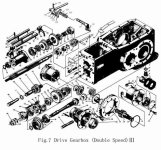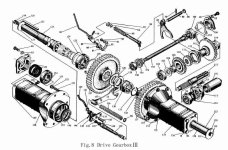HomeBrew2
Banned
Soundguy said:Most gear tractor trannies are not Synchromesh...
Soundguy
Well, yeh, I think that's pretty well known and is accepted by all on this thread. Synchros are an added feature to the dog clutches of a constant (gear) mesh transmission that equalizes the the speed of the input and output of the transmission so the dogs can engage without the operator having to match those speeds manually (skill) or by double clutching (not much skill).
My reference and question was about the comments about "grinding" the GEARS in a tractor transmission, which is impossible in an automotive transmission because all gears are always meshed. My guess is that tractors have a similar transmission and the "grinding" is really the dogs grinding just like in a car/truck. My guess is that nobody has made a non-constant mesh transmission for 100+ years ... ?

